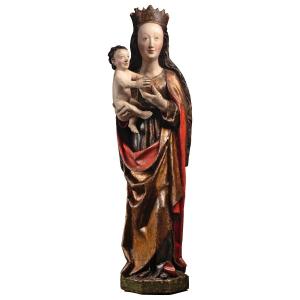Mid 16th century
Oil on oak panel with its original ebonized frame
Dimensions : 53,50 cm x 40 cm
Our panel, originally the central part of a triptych, illustrates one of the subjects that has become universal in Western art, the crucifixion scene.
The crucifixion of Jesus, recounted in all the gospels, is one of the episodes of the Passion of Christ. The contemplation of his death by the faithful is and has always been an intense devotional exercise. The suffering of Christ had to be made as realistic as possible by the artist, in order to move the spectators and give rise to piety.
Christ with his emaciated body is suspended from his cross. He is girded at the loins by a short perizonium with a slightly transparent appearance. The arms are almost horizontal and the fingers close over the nails which pierce the palms of his hands. In an attitude of resignation and abandonment his head crowned with thorns is leaning on his right shoulder, but his eyes remain open while his wounds shed a few drops of blood and show how painful the torture he is enduring is.
At the foot of the cross on his right, the Virgin stands upright buried in an immense dark blue cloak, from which only her face and hands stand out. Her hands with interlaced fingers joined in front of her, her face inclined, her eyes lowered, she no longer has the strength to look at the suffering of her son.
At the foot of the cross, Mary Magdalene kneels, her eyes lowered, embraces the bottom of the cross, in an attitude full of tenderness and adoration she rests her cheek against the foot of Christ.
Saint John the Baptist on her left, his eyes raised towards Jesus, raises his hands with open palms and fingers extended in a sign of prayer.
Thick grey clouds obscure the sky, which contrasts with a rocky and wild landscape with earthy tones, while Jerusalem nestled in the hills stands out in all its splendour, the many buildings with conical roofs and domes, among which we recognise the Temple of Jerusalem on the right and the complex of the Holy Sepulchre on the left.
Our work, marked by a Gothic influence typical of the Bruges school, is close to the works of Adriaen Isenbrandt. Several paintings that are attributed to his workshop display the same composition bringing together the three figures around the cross, but differ in the format, landscape and perspective.
The reduced format and the shape of our painting allow us to deduce its origin as a small portable triptych or for private devotion. The wings (disappeared) were probably intended to represent the donors (the sponsors of the painting) as can be seen on the triptych kept in a private collection (listed in the RKD database in Amsterdam)
Related works:
- workshop of Adriaen Isenbrandt (active 1510-1551), around 1525, oil on panel 44.77x34.29 cm), Los Angeles County Museum, USA
- Workshop of Adriaen Isenbrandt 49.7 x 39.7 cm, mid-16th century, Philadelphia Museum of Art,
- Workshop of Adriaen Isenbrandt 45.3 x 35.5 cm, mid-16th century, Royal Museums of Fine Arts of Belgium, Brussels (inv. 8720)
- Triptych Crucifixion with donors, Workshop of Adriaen Isenbrandt, mid-16th century, 60.5 x 38.5 cm, private collection, listed in the RKD database










































 Le Magazine de PROANTIC
Le Magazine de PROANTIC TRÉSORS Magazine
TRÉSORS Magazine Rivista Artiquariato
Rivista Artiquariato